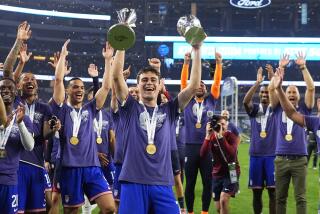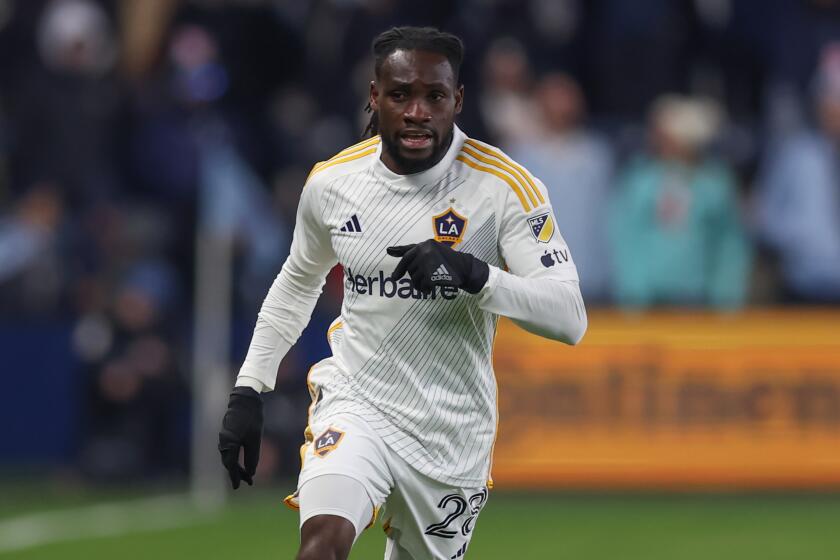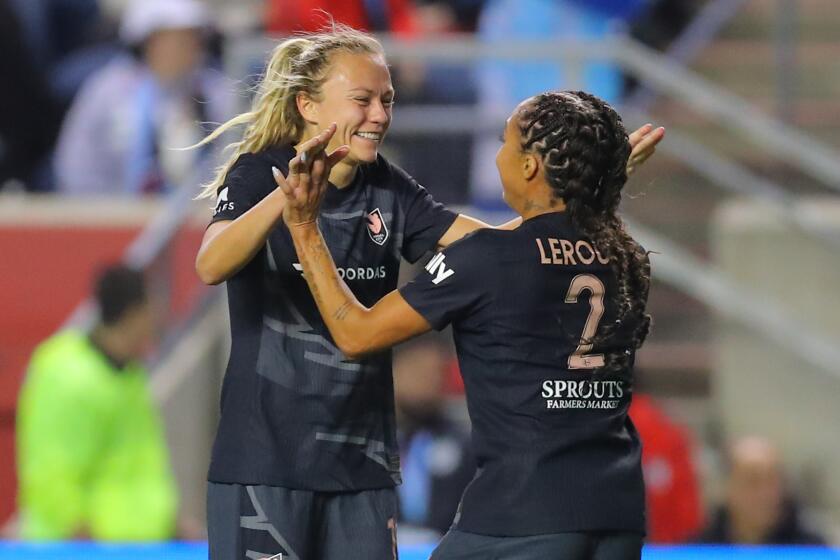Two of the game’s greatest never donned a uniform
It was three decades ago that the paths of Lamar Hunt and Ahmet Ertegun crossed. The two men came from vastly dissimilar backgrounds, but Hunt, from El Dorado, Ark., and Ertegun, from Uskudar, Turkey, found common ground on the playing fields of America.
Each had a dream, and because each pursued it with a will, their soccer legacy is likely to echo down through the years in this country.
Hunt died last Wednesday of prostate cancer at Presbyterian Hospital in Dallas. One day later, Ertegun died at New York Presbyterian Hospital of complications following a head injury suffered in a fall at a Rolling Stones concert.
Hunt was 74, Ertegun 83.
Together and separately, they helped make U.S. soccer what it is today.
Ertegun, whose fame was achieved in the music industry, and his brother, Nesuhi, were the financial clout behind the New York Cosmos of the old North American Soccer League.
It was the Erteguns -- Nesuhi more so than Ahmet -- who made the Cosmos the first American soccer team to be recognized worldwide. They brought such aging stars as Pele, Franz Beckenbauer, Carlos Alberto and others to the Meadowlands and soon crowds of 70,000 and more were showing up at Giants Stadium.
With the Erteguns pulling the strings, Cosmos games, for a few brief glorious years, became the place to be seen, the place where in the locker room Mick Jagger could very likely be spotted rubbing shoulders with Henry Kissinger.
Thirty years later, soccer in the U.S. has yet to regain those dizzy heights.
But the sport today is on a much firmer footing. The NASL folded in 1985, Nesuhi Ertegun died in 1989 and his brother Ahmet faded from the soccer scene. Not so Hunt, who lost an estimated $20 million on the NASL’s Dallas Tornado but never relinquished his belief that the sport could and would one day become as American a pastime as football, baseball, basketball and hockey.
“I have no doubts that it will be a major sport in the United States,” Hunt said in 2002. “I’m probably not going to live to see that day because Americans are a little afraid of getting interested in something at which they’re not very good. So it depends on how quickly the U.S. can become good.”
Hunt’s achievements in football have been well documented, and his interest -- not to mention investment -- in tennis, basketball and other sports are equally well known, but for some reason soccer held a special place in his heart.
With the exception of the World Cup in Argentina in 1978, when he feared for the safety of his young sons, and Germany ‘06, when poor health prevented him from traveling, he attended nine of the past 11 World Cups, starting with England ’66. Games involving Brazil were his particular passion and probably the reason why he fell under soccer’s spell.
Hunt was far more than a fan, though. Having seen the game played at its highest level across the globe, he had a vision of it reaching similar heights in the U.S.
“There is no doubt,” said Major League Soccer Commissioner Don Garber last week, “that the sport of soccer in America would not be where it is today without Lamar Hunt’s passion . . . and unrelenting love of the game.
“When Lamar was talking about soccer, there was that glint in his eye.”
Unfazed by the NASL’s collapse after almost 20 years, Hunt became a founding investor in MLS when the league was created in 1996. He owned the Kansas City Wizards, which he sold earlier this year, the Columbus Crew and, later, the Dallas Burn, now FC Dallas.
Perhaps his most influential move, however, was in building Crew Stadium, using more than $28 million of his own money to construct the first soccer-specific stadium in the country.
It became a template, the foundation, so to speak, of other stadiums, including the Home Depot Center in Carson. Hunt even followed his own lead and $65-million Pizza Hut Park in the Dallas suburb of Frisco, Texas, was the result.
Hunt was about more than bricks and mortar, though. It was what Garber called his “quiet confidence” that inspired fellow MLS investors such as Robert Kraft and Phil Anschutz to keep believing in the sport.
Hunt’s own faith in soccer’s future was unshakeable.
When former UCLA defender Jimmy Conrad returned from Germany after playing for the U.S. in the World Cup this summer, he ran into Hunt.
“All he wanted to talk about was the World Cup, the ripple effect it will have on MLS and how he intends to make the league stronger than ever,” Conrad told the Kansas City Star.
If soccer in the U.S. had a father figure, Hunt was that man.
Unlike his own father, flamboyant, eccentric and controversial oil billionaire H.L. Hunt, Lamar was low-key, self-effacing and modest, a humble man unimpressed by either his wealth or his many accomplishments.
“If you didn’t know he was Lamar Hunt, you would never know he was Lamar Hunt,” said former Columbus Crew spokesman Jeff Wuerth. “He was so unassuming, so down to earth. He treated you as an equal, no matter who you were.”
American soccer could not have asked for a better role model.
Steve Davis, a former columnist for the Dallas Morning News, recalled a conversation he once had with longtime SMU soccer Coach Schellas Hyndman.
“[Hunt] somehow made you feel like the most important person in the room,” Hyndman said of Hunt, calling him “a model for how every human being should conduct his life.”
Last summer, Davis bumped into Hunt at a movie theater in Dallas where “Once in a Lifetime,” a film about the Ertegun-era Cosmos and the NASL, was showing. It had been Hunt’s birthday wish to his family to see the film.
“That was just great!” he told Davis afterward. “I’ve never seen a movie where I knew all the stars.”
Typical of the man, Hunt’s own vital role in the league’s story went unmentioned.
“There quite simply has never been a more influential person in sports in the United States,” said Sunil Gulati, the president of U.S. Soccer. “When it comes to soccer, he was the pioneer, the innovator and the patriarch all rolled into one. And that statement was as true in 1966 as it is in 2006.”






